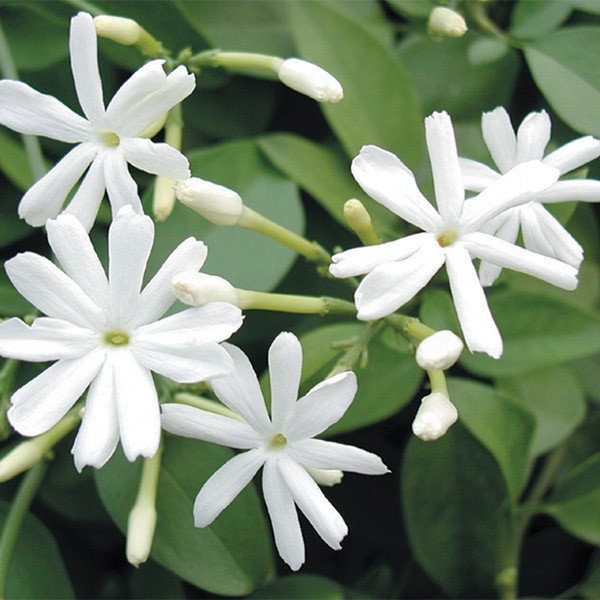Five stunning jasmine flowers to remind us of the sweetness of life
by Laurelynn Martin and Byron Martin
The sweet scents of jasmine help us ease the transition with back to work and back to school after the lazy days of summer. A genus of shrubs and vines in the olive family, jasmine contains around 200 species native to tropical and warm temperate regions. Widely cultivated for the characteristic fragrance of their flowers, jasmine flowers emit some of the sweetest fragrances on earth, and can bring the indoor gardener that soothing sense of relaxing into what’s next.
You can even make your own calming jasmine water that’s a refreshing drink like cucumber or lemon water. Drinking jasmine water in the morning starts your day with an almost spa-like benefit. Simply pick the flowers at night and place them in a covered jar of filtered or spring water. By the next morning, the sweetly infused water is waiting for you to start your day. You can also add jasmine flowers to black or green tea and this tasty and healthy brew is called jasmine tea.
Here are a few of our favorite flowering jasmine plants…
The Jasmine sambac varieties are known for their sweet fragrance, ease of growing and floriferous nature. One of our favorites is Jasmine ‘Maid of Orleans’ (Jasminum sambac). It is always in flower and blooms at 12” tall. This everblooming jasmine has a bushy growth habit and does particularly well on windowsills. The fragrance of the white flowers clears the air and adds a touch of peaceful tranquility.
Jasmine ‘Grand Duke of Tuscany’ (Jasminum sambac) is another favorite. The double flowers resemble small carnations. The upright growth habit makes for a nice outdoor summer plant but come fall, it is ready to be brought into a sunny room and fill the space with its rich fragrance.
We offer some vining jasmines like the multi-petaled Azores Jasmine (Jasminum azoricum). It flowers heavily in the fall, spring and summer and it’s best grown on a stake or trellis. This one is relatively free of insects and diseases and its vigorous growth habit will cover a trellis in no time.
Another everblooming jasmine with bright yellow, sweetly scented flowers is Jasmine ‘Revolutum’ (Jasminum humile). It is a stiff-stemmed vine and adds a bit of dimension to the windowsill with its buttery yellow color. Although originating in Asia, the Royal Horticultural Society has long been enamored with Jasmine ‘Revolutum’ and gave it the prestigious Award of Garden Merit.
Finally, we would be remiss if we didn’t mention the long-time favorite jasmine of Logee’s, the Winter Jasmine, also known as Jasmine polyanthum. In the dead of winter, you can walk into our “Big House” and growing in the top of a tree is our Winter Jasmine. When in full bloom, a blizzard of snow white flowers appears filling the entire greenhouse with a fragrance that gives us hope and promise that spring is just around the corner. Remember, Winter Jasmine needs a cool period in the fall to initiate flower bud formation and then it will bloom reliably from December to March.
As the fragrance of these treasured flowers fills your home, you’ll enjoy the aromatherapy benefits of jasmine to relieve stress and boost your mood. You can learn more about these lovely jasmine flowers below:
- Jasmine ‘Maid of Orleans’ (Jasminum sambac)
- Jasmine ‘Grand Duke of Tuscany’ (Jasminum sambac)
- Azores Jasmine (Jasminum azoricum)
- Jasmine ‘Revolutum’ (Jasminum humile)
- Winter Jasmine (Jasmine polyanthum)
Thank you for visiting Logee’s. Before you go, please be sure to explore our selection of fruiting, rare and tropical plants. And don’t forget to request your free Logee’s catalog while you’re here, too!








